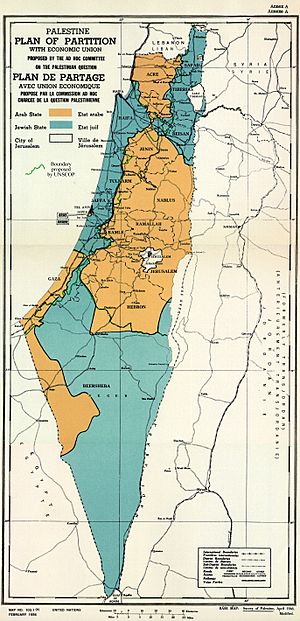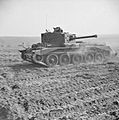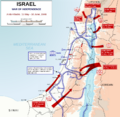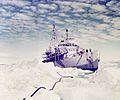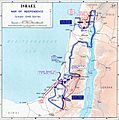1948 Arab–Israeli War facts for kids
Quick facts for kids 1948 Arab–Israeli War |
|||||||||
|---|---|---|---|---|---|---|---|---|---|
| Part of the 1948 Palestine war | |||||||||
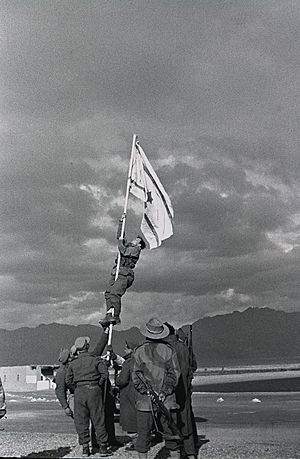 Captain Avraham "Bren" Adan raising the Ink Flag at Umm Rashrash (a site now in Eilat), marking the end of the war |
|||||||||
|
|||||||||
| Belligerents | |||||||||
|
Before 26 May 1948:
After 26 May 1948: Foreign volunteers: Mahal |
Irregulars: |
||||||||
| Commanders and leaders | |||||||||
| Strength | |||||||||
| Israel: 29,677 (initially) 117,500 (finally) |
Egypt: 10,000 initially, rising to 20,000 Transjordan: 7,500–10,000 Iraq: 2,000 initially, rising to 15,000–18,000 Syria: 2,500–5,000 Lebanon: 436 Saudi Arabia: 800–1,200 (Egyptian command) Yemen: 300 Arab Liberation Army: 3,500–6,000. Total: 13,000 (initial) 51,100 (minimum) 63,500 (maximum) |
||||||||
| Casualties and losses | |||||||||
| 6,373 killed (about 4,000 fighters and 2,400 civilians) | Arab armies: 3,700–7,000 killed Palestinian Arabs: 3,000–13,000 killed (both fighters and civilians) |
||||||||
The 1948 Arab–Israeli War, also known as the First Arab–Israeli War, was a major conflict in the Middle East. It was the second and final part of the 1948 Palestine war.
Contents
History of the Conflict
The war officially started after the British Mandate for Palestine ended at midnight on May 14, 1948. This was the day the British government stopped controlling the area of Palestine. Earlier that day, Israel had declared itself an independent country. On the morning of May 15, a group of Arab countries sent their armies into the former British Palestine.
How the War Began
The United Nations Partition Plan for Palestine was approved on November 29, 1947. This plan aimed to divide Palestine into an Arab state, a Jewish state, and a special international zone for Jerusalem and Bethlehem. The very next day, fighting began. Seven Jewish people were killed in an attack by Arab fighters. This event is often seen as the start of the civil war.
Before this, there had been tension and fighting between Arabs, Jews, and the British for many years. This tension grew after the Balfour Declaration in 1917 and the creation of the British Mandate of Palestine in 1920. British rules made both Arabs and Jews unhappy. Arabs protested in the 1936–1939 Arab revolt in Palestine. Jewish groups also protested, leading to the Jewish insurgency in Palestine from 1944 to 1947.
The War Escalates
On May 15, 1948, the civil war changed into a bigger conflict between the new state of Israel and several Arab countries. Egypt, Transjordan, Syria, and troops from Iraq entered Palestine. These invading armies took control of Arab areas. They quickly attacked Israeli forces and some Jewish settlements. The fighting lasted for 10 months, mostly in the former British Mandate territory, the Sinai Peninsula, and southern Lebanon. There were also several times when fighting stopped for a truce.
Results of the War
After the war, Israel controlled the area the UN had suggested for a Jewish state. It also took control of about 60% of the area planned for the Arab state. This included cities like Jaffa, Lydda, and Ramle, parts of the Upper Galilee, and some of the Negev desert. Israel also gained control of West Jerusalem. This area was supposed to be part of an international zone.
Transjordan took control of East Jerusalem and the area known as the West Bank. They officially made it part of their country the next year. The Egyptian army took control of the Gaza Strip.
The war caused many people to move. About 700,000 Palestinian Arabs either fled or were forced to leave their homes in the area that became Israel. They became Palestinian refugees. Palestinians call this event the Nakba, which means "the catastrophe." At the same time, about 700,000 Jewish people moved to Israel in the three years after the war. Many of them came from surrounding Arab countries.
Aftermath of the War
Peace Agreements

Boundaries defined in the 1947 UN Partition Plan for Palestine:
Armistice Demarcation Lines of 1949 (Green Line):
In 1949, Israel signed separate peace agreements, called armistices, with Egypt (February 24), Lebanon (March 23), Transjordan (April 3), and Syria (July 20). These agreements set new borders, known as the Armistice Demarcation Lines.
After these agreements, Israel controlled about three-quarters of the former British Mandate territory. This was about one-third more land than the UN partition plan had given to the Jewish state. Israel now controlled 78% of the former Mandatory Palestine. This included the entire Galilee and Jezreel Valley in the north, the whole Negev in the south, West Jerusalem, and the coastal plain in the center.
These new borders became known as the "Green Line". The Gaza Strip was occupied by Egypt, and the West Bank (including East Jerusalem) was occupied by Transjordan. The United Nations Truce Supervision Organization was created to watch over the ceasefires and make sure the agreements were followed.
People Affected by the War
Israel lost 6,373 people in the war. This was about 1% of its population at the time. Around 4,000 were soldiers, and 2,400 were civilians. Many of the soldiers were Holocaust survivors.
The exact number of Arab casualties is not fully known. Estimates suggest between 3,700 and 7,000 Arab soldiers were killed. Palestinian historians believe that between 3,000 and 13,000 Palestinians, both fighters and civilians, died.
Changes in Population
During the civil war and the 1948 Arab–Israeli War, about 750,000 Palestinian Arabs left or were forced from their homes. This was out of about 1.2 million Arabs living in the former British Mandate of Palestine. This event is called the Nakba by Palestinians. In 1951, the UN estimated that 711,000 Palestinian refugees had been displaced from Israel.
These displaced Palestinians, known as Palestinian refugees, settled in refugee camps across the Arab world. The United Nations created UNRWA to provide help to these refugees. Many Arab nations did not allow Palestinian refugees to become citizens. They wanted them to return to their original homes.
Refugee status was also passed down to their children and grandchildren. Most of them were also not given citizenship in Arab countries, except in Transjordan. The Arab League told its members not to give Palestinians citizenship. This was to "protect their right of return to their homeland." Today, more than 1.4 million Palestinians still live in 58 recognized refugee camps. More than 5 million Palestinians live outside Israel and the Palestinian territories.
The issue of Palestinian refugees and their right to return remains a major part of the Arab–Israeli conflict.
Jewish Immigration to Israel
In the three years after the war (from May 1948 to the end of 1951), 700,000 Jewish people moved to Israel. This doubled the Jewish population there. Many of these new immigrants settled along the borders and in former Arab lands. Over 300,000 came from Asian and North African countries.
Jewish people left Arab and Muslim countries for many reasons. The war made Arab communities more hostile towards local Jewish people. News of Israel's victory gave some Jewish people hope. Also, Israel actively encouraged Jewish people to move there. They hoped for better economic opportunities and safety in a Jewish state. Some Arab governments, like Egypt, sometimes held their Jewish communities hostage. Persecution, political problems, and violent attacks also played a role. About 800,000 to 1,000,000 Jewish people eventually left the Arab world over the next 30 years because of these reasons. An estimated 650,000 of them settled in Israel.
Images for kids
-
IDF soldiers of the Samson's Foxes unit advance in a captured Egyptian Bren Gun carrier.
-
Mathematics professor Michael Fekete, the Provost of the Hebrew University of Jerusalem, with his water quota, during the siege of Jerusalem
-
Kaukji, the Arab Liberation Army commander
-
An Egyptian Spitfire shot down over Tel Aviv on 15 May 1948
-
Northland in Greenland circa 1944 which became the Israeli INS Eilat
-
UN Palestine mediator, Folke Bernadotte, assassinated in September 1948 by the militant group Lehi
-
Israeli armoured vehicles in Lydda airport after the town's capture by Israeli forces
-
Beit Horon Battalion soldiers in the Russian Compound in Jerusalem, 1948
-
The funeral of a Royal Air Force pilot killed during a clash with the Israeli Air Force
-
Arab Legion soldier standing in ruins of the most sacred Synagogue, the "Hurva", Old City.
-
Jewish residents of Jerusalem fleeing during the battle for the Old City
See also
 In Spanish: Guerra árabe-israelí de 1948 para niños
In Spanish: Guerra árabe-israelí de 1948 para niños
- List of battles and operations in the 1948 Palestine war
- List of modern conflicts in the Middle East


